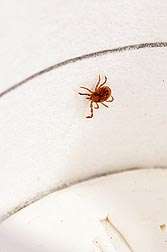In a lab test, this lone star tick nymph (Amblyomma americanum) was exposed to a citrus rind chemical, placed upside down inside an untreated filter paper cylinder, and observed to see whether it could right itself. Credit: Stephen Ausmus
Why do birds, monkeys and other animals rub themselves with citrus and creatures like millipedes? One likely reason is because certain plants and arthropods contain natural repellents.
Scientists with the U.S. Department of Agriculture (USDA) and the Smithsonian Conservation Biology Institute (SCBI) at the National Zoological Park in Front Royal, Va., examined citrus compounds and millipedes for effectiveness against ticks. John Carroll, an entomologist with the Agricultural Research Service (ARS) at the Henry A. Wallace Beltsville Agricultural Research Center (BARC) in Beltsville, Md., and SCBI researcher Paul Weldon tested the responses of ticks to more than 20 different compounds in citrus extracts. ARS is the chief intramural scientific research agency of USDA.
Ticks were allowed to climb on vertical paper strips containing lemon rind exudates and other citrus chemicals. Repellency evaluation was based on whether ticks crawled into treated areas, continued to move, turned around, crawled back down or fell. Experiments also involved putting ticks inside treated filter-paper packets. After one hour, the ticks were removed, placed on their backs and timed to see if and when they could right themselves and climb out of a low enclosure and onto a fingertip.
Carroll, who works in BARC's Invasive Insect Biocontrol and Behavior Laboratory, found that some ticks were unable to crawl out of enclosures or even right themselves. Of 24 ticks exposed to one citrus chemical, only one righted itself. Of the chemicals tested, one killed or disabled ticks exposed to it for an hour. Several other chemicals kept ticks from climbing onto a fingertip.
To get to the bottom of why some animals anoint themselves with crushed millipedes, scientists used similar techniques to test ticks' responses to three benzoquinone chemicals found in millipedes. One benzoquinone chemical killed ticks, one repelled them and all three benzoquinones hampered efforts of ticks to right themselves and climb. Higher concentrations of these chemicals were able to impair ticks' ability to climb for several months.
More information: Read more about this research in the March 2013 issue of Agricultural Research magazine.
Journal information: Agricultural Research
Provided by Agricultural Research Service




















